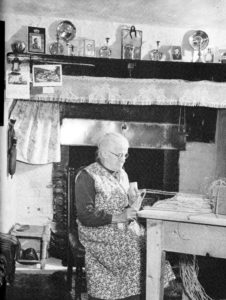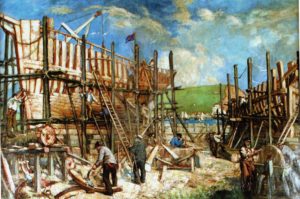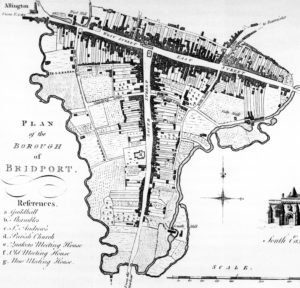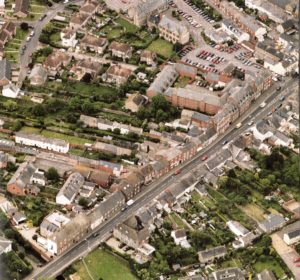Why maritime history matters: Maritime highways – A personal journey.
In his Pulitzer Prize winning book aptly titled The Prize, Daniel Yergin quotes Admiral ‘Jacky’ Fisher as telling Winston Churchill, on the latter’s appointment to First Lord of the Admiralty in September 1911, ‘east of Suez oil is cheaper than coal.’[1] It later became clear that Churchill’s subsequent decision to convert the Royal Navy to oil had a huge impact on the geopolitical and economic growth of the world. Other impacts of maritime history are often not so dramatic or visible, but over time have become no less important. In what follows I will use a personal experience to demonstrate how maritime history has greatly influenced both our personal and collective lives and how it can contribute to understanding many aspects of our modern world.

Photograph produced by the British Ministry of Information in the late 1930s demonstrating how Bridport women’s home work contributed to the net making industry. By permission of The Dovecote Press
Born and raised in Bridport, Dorset, a small coastal town almost exactly halfway between the major navy port cities of Portsmouth and Plymouth, I was surrounded by the history of the sea and the material and human demands of the maritime community. Not many children shared a living room with fishing nets, but my mother’s home work in finishing nets, newly produced on machines in a local factory, was a common occupation in the town. My home was in a row of cottages down an alleyway, with an outside pathway that had served as a rope walk prior to the mechanisation of rope making. These alleyways, clearly seen on a town plan dated 1774,[2] still form a unique part of the architecture of the town, as shown on either side of the main street, in a recent aerial photograph.[3]
The earliest documented evidence of rope and net making in Bridport can be found in orders from King John to supply his navy with rope and cloth in 1213.[4] The town continued to grow around this industry, until in the late nineteenth and early twentieth centuries there were seven great mills and few families did not have a member employed in the industry. But Bridport’s connection with maritime history does not end with the supply of rope and nets, for just one mile south of the town sits Bridport Harbour, now known as West Bay.[5]
Set on one of the most treacherous parts of the coast, particularly for sailing ships trapped by an on-shore wind within Lyme Bay, West Bay had a working commercial harbour, until tourism and leisure took over in the 1980s. There, small freighters brought hemp for the rope industry and ropes, nets and pea gravel from nearby Chesil Beach were exported. Today, the existence of warehouses and workers cottages show evidence of that maritime industry. Also, the naming of a new residential area ‘Old Shipyard Centre’ reveals that West Bay once had a thriving ship building activity. A total of 400 ships were built on six slipways in Bridport Harbour between 1769 and 1879, including sloops for the Royal Navy and a privateer, destined to take part in the American war of independence. The largest vessel built in the shipyard was a fast clipper of 1,060 tons, which was employed carrying passengers and cargo on the London to Sydney, Australia route.[6]
Bridport’s rope making and harbour today lends character to the town and has defined its economic and social history. My own experience of maritime history and particularly the maritime connections forged between nations, continued with a move in mid-life to my new home in Montreal, Canada.
Montreal is a major port city that handles a significant amount of commercial traffic, both trans oceanic and from the Great Lakes. Montreal sits at the entrance to the St Lawrence Seaway, which since its opening in 1959 has enabled ocean going merchant ships to travel onward to Toronto and other ports on the Great Lakes. Maritime access to the rest of the world, by way of the St Lawrence river, has defined Montreal commercial and social life. The significance of this is seen in a ceremony on New Years day when the Captain of the first ship to cross the boundary of the Port of Montreal is presented with a gold headed cane. This ceremony is a hold over from the time when ice in the upper St Lawrence isolated Montreal from the world throughout the winter months and the arrival of the first ship in spring was a major event to be celebrated by the citizens of the city.[7]
Maritime activity has very much shaped many aspects of the broader Canadian economy, culture and society. Beyond the development of the Royal Navy ports of Halifax and Esquimalt (Victoria BC), there are other port towns and cities around the Great Lakes, some like Kingston, Ontario, associated with the Royal Navy and its battles in the war of 1812 and others such as Toronto, Thunder Bay and St Catharine’s, developed due to commercial trade.[8] Other features of Canada can be attributed to the material needs of the Royal Navy. Today, a number of mill towns in New Brunswick service the pulp and paper industry. These same towns were founded and flourished when the Royal Navy, deprived of its sources of wood in the Baltic by Napoleon, looked for an alternative source in Canada, encouraging men to leave their settlements on the shores of the St Lawrence river and move up inland rivers, creating new settlements.[9]
For a Dorset man, the most fascinating aspect of the development of Canada is in the history of Newfoundland. Due to the early settlement of Newfoundland by West Country fishermen and the continued trade between Dorset and Newfoundland, the culture of Newfoundland has been shaped by the maritime highway between those two points. In out ports, on the isolated East coast, you may hear a resident say ‘dout the fire’ an expression heard nowhere else but within a twenty-mile radius of Bridport.[10] In fact, researchers have discovered a whole lexicon of common words and phrases that can be traced to the maritime interchange between the west country of England and Newfoundland.[11] Beyond the founding of these initial settlements, there has been a constant maritime trade between Bridport and Newfoundland. The regular passage of a ship would carry Bridport rope and nets to Newfoundland, and now unfortunately relegated to a public convenience, a building in West Bay, is known as the salt house for its role in storing salt for the Newfoundland fish trade.[12] Further evidence of this maritime connection between West Dorset and North America can be found in the music and folklore of Newfoundland and Labrador, demonstrating not only the influence of immigrants on Canada cultural identity but also the influence of those indulged in maritime trade between two continents.
My own personal journey, that has followed the connection between two ends of a 2,000-mile-long ocean highway, highlights the impact of maritime activity on two specific communities. In the greater span of maritime history, the story of Bridport typifies the development of a number of smaller British towns based on maritime trade and the material needs of the Royal Navy. Beyond Britain, the world is full of connections along ocean highways, where economic and cultural influences similar to those between Dorset and Newfoundland can be found. Pockets of British culture in places as distant from Britain as Malta, the Falkland Islands and Hong Kong, of German Culture in Tsingtao, China,[13] Portuguese culture in Macau, Spanish culture in Manila and in Britain where a population of the East End of London has roots derived from West and East Indian Lascars, employed in British merchant activity, all can be attributed to the past needs of the maritime community and are a demonstration of why maritime history matters.[14]
Notes
* Image one is part of a series of murals in Bridport Town Hall by Newbery, 1924, in Mike Williams, Bridport and West Bay: the buildings of the flax and hemp industry (Swindon: English Heritage, 2006), 10.
[1] Daniel Yergin, The prize: The epic quest for oil, money & power (New York: Simon and Schuster, 2011), 139.
[2] J. Hutchins, “The History and Antiquities of the County of Dorset Vol1, (London: Bower and Nichols) 233,” in Mike Williams, Bridport and West Bay: the buildings of the flax and hemp industry (Swindon: English Heritage, 2006), 8.
[3] Williams, Bridport, 21.
[4] Williams, Bridport, 7.
[5] Bridport Harbour was renamed West Bay by the Great Western Railway to attract tourists in the mid-nineteenth century, Williams, Bridport, 46.
[6] “The Speedy-Bridport Clipper” taken from the Illustrated London News, 10/12/1853, accessed 12/08/2018,
http://www.pbenyon.plus.com/Gazette/Shipping_Sail/Speedy_of_Bridport.html.
[7] “Port of Montreal presents gold-headed cane to first ocean-going ship of 2017,” CBC News 01/01/ 2017, accessed 10/07/2018, https://www.cbc.ca/news/canada/montreal/gold-headed-cane-chem-sirius-1.3918193
[8] Richard Preston, ‘Anglo-American Confrontation 1775-1870,’ in The Defence of the Undefended Border: Planning for War in North America, 1867-1938 (Kingston: McGill-Queen’s University Press, 1977), 9-21.
[9] Henry Vivian Nelles, A little history of Canada (Don Mills, Ont.: Oxford University Press, 2004), 73-76.
[10] An out port is an isolated settlement on the coast of Newfoundland and Labrador. ‘To dout the fire,’ To put out fire or flame, from ‘The Language of Old Burton, Burton Bradstock, Dorset,’ Burton Bradstock Village Web Site, accessed 09/10/2017, https://www.burtonbradstock.org.uk/History/Georgie%20Northover%20achive/Douglas%20Northover%27s%20Language%20of%20Old%20Burton.htm
[11] Sandra Clarke and Phillip Hiscock, The Dialect Atlas of Newfoundland and Labrador, accessed 10/07/2018, http://www.dialectatlas.mun.ca/#
[12] The Mary Hounsell from Bridport Museum Files, accessed 09/10/ 2017, http://www.hounsell.org.uk/info.html.
[13] Home port, prior to and during the First World War, of Admiral Graf Spee’s ill fated East Asiatic Squadron. Reinhard K. Lochner, ‘A New Hong Kong or Port Arthur,’ in The Last Gentleman-of-War: The raider exploits of the cruiser Emden (Annapolis: US Naval Institute Press, 1988), 3-20.
[14] ‘The Lascars: Britain’s Colonial Sailors’, Our Migration Story, accessed 10/07/2018, https://www.ourmigrationstory.org.uk/oms/the-lascars-britains-colonial-era-sailors













It was great to read the history of Bridports involvement in Naval History with memories of my Grandmother & Mother doing nets at home also that my Father & My Husbands Father both worked for the famous net factory Gundrys . It was really nice that in fact it was research by our good friend Peter Garland, who has achieved so much, well done Pete
Nice article Peter, you’ve earned a ‘BZ’ from a retired RCN Officer.
An interesting and nostalgic read, Peter. My family’s Bridport roots go back three centuries (the clue is in the name!) and I have many happy boyhood memories of days spent in and around the Harbour (when the sun always shone of course). A particular treat was being able to accompany my father (a Commissioner for Oaths) aboard the visiting German timber ships when the Master needed to record a ‘Protest’ for insurance purposes.